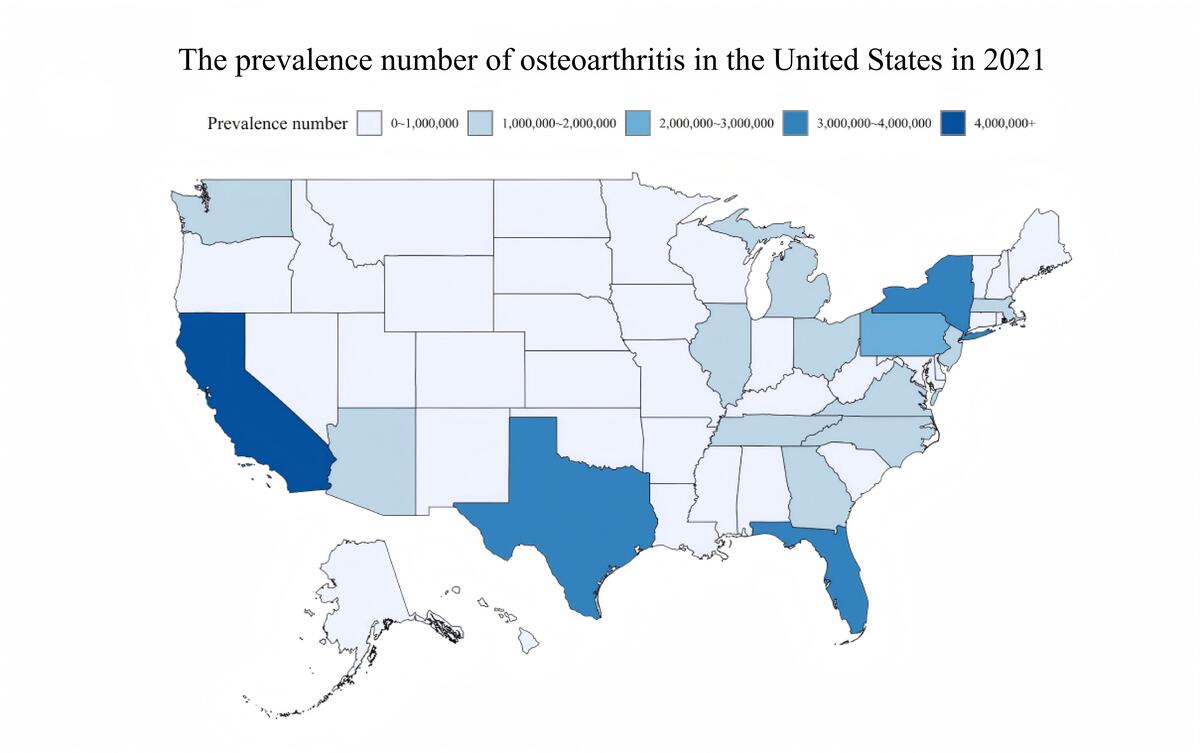Current issue
Archive
Manuscripts accepted
About the Journal
Editorial office
Editorial board
Section Editors
Abstracting and indexing
Subscription
Contact
Ethical standards and procedures
Most read articles
Instructions for authors
Article Processing Charge (APC)
Regulations of paying article processing charge (APC)
PUBLIC HEALTH / RESEARCH PAPER
Epidemiological trends and burden of osteoarthritis in United States: Insights from the GBD 2021 study
1
Gaozhou People's Hospital, China
These authors had equal contribution to this work
Submission date: 2025-04-21
Final revision date: 2025-06-23
Acceptance date: 2025-06-29
Online publication date: 2025-07-02
KEYWORDS
TOPICS
ABSTRACT
Introduction:
This study aimed to analyze the epidemiological trends and burden of osteoarthritis (OA) in the United States (U.S.) from 1990 to 2021 using data from the Global Burden of Disease (GBD) 2021 study, with a focus on sex, age, and geographic disparities.
Material and methods:
We utilized GBD 2021 data to examine OA incidence, prevalence, years lived with disability (YLDs), and age-standardized rates in U.S., by gender, age group and different states. Decomposition analysis was performed to assess contributions from population growth, aging, and epidemiological changes.
Results:
Between 1990 and 2021, OA incidence and prevalence in the U.S. increased by 80.3% and 90.3%, respectively. Female consistently exhibited higher burden than male, with the highest incidence rate in the 55–59 age group. Geographically, California had the highest absolute case numbers, while Pennsylvania showed the highest age-standardized rates. Knee OA contributed most to disability, though hand OA dominated in the oldest populations. Decomposition analysis revealed that population growth (67.55%) was the primary drivers of rising OA incidence.
Conclusions:
The OA burden in the U.S. has risen substantially over the past three decades, with notable disparities by sex, age, and region. Targeted public health strategies addressing prevention, early detection, and equitable healthcare access are urgently needed to mitigate this growing challenge.
This study aimed to analyze the epidemiological trends and burden of osteoarthritis (OA) in the United States (U.S.) from 1990 to 2021 using data from the Global Burden of Disease (GBD) 2021 study, with a focus on sex, age, and geographic disparities.
Material and methods:
We utilized GBD 2021 data to examine OA incidence, prevalence, years lived with disability (YLDs), and age-standardized rates in U.S., by gender, age group and different states. Decomposition analysis was performed to assess contributions from population growth, aging, and epidemiological changes.
Results:
Between 1990 and 2021, OA incidence and prevalence in the U.S. increased by 80.3% and 90.3%, respectively. Female consistently exhibited higher burden than male, with the highest incidence rate in the 55–59 age group. Geographically, California had the highest absolute case numbers, while Pennsylvania showed the highest age-standardized rates. Knee OA contributed most to disability, though hand OA dominated in the oldest populations. Decomposition analysis revealed that population growth (67.55%) was the primary drivers of rising OA incidence.
Conclusions:
The OA burden in the U.S. has risen substantially over the past three decades, with notable disparities by sex, age, and region. Targeted public health strategies addressing prevention, early detection, and equitable healthcare access are urgently needed to mitigate this growing challenge.
Share
RELATED ARTICLE
We process personal data collected when visiting the website. The function of obtaining information about users and their behavior is carried out by voluntarily entered information in forms and saving cookies in end devices. Data, including cookies, are used to provide services, improve the user experience and to analyze the traffic in accordance with the Privacy policy. Data are also collected and processed by Google Analytics tool (more).
You can change cookies settings in your browser. Restricted use of cookies in the browser configuration may affect some functionalities of the website.
You can change cookies settings in your browser. Restricted use of cookies in the browser configuration may affect some functionalities of the website.



